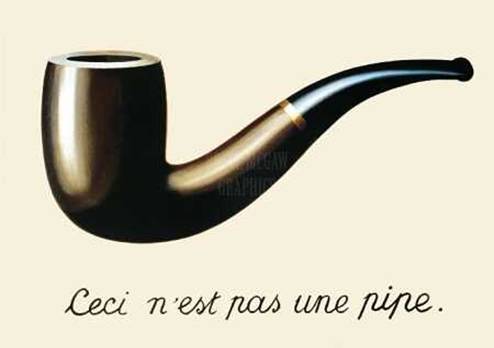 |
|
Introduction: Notes on Visual Rhetoric David Blakesley continued . . .
Consider this much-discussed painting, The Treachery of Images ("Ceci n'est pas une pipe"; "This is not a pipe"), by the French surrealist painter, René Magritte (1898-1967). Magritte foregrounds and problematizes the way that we attribute significance to images, as well as the complicated relationship between the verbal and the visual. As Foucault, Mitchell, and Zizek have discussed, the painting challenges the "correspondence" or natural theory of the image, the idea that an image stands unambiguously for (or in relation to) the object which it represents (or re-presents) or that the image can have a stable semantic or spatial relationship with the verbal sign.
Magritte's painting is dominated by the image of a large pipe set against a beige background, above the declaration, written in script, Ceci n'est pas une pipe ("This is not a pipe"). The image of the pipe and that sentence share a dialectical relationship, meaning that each comments on the other. The significance of the painting is incomplete when we consider each in isolation. The image of the pipe alone isn't especially interesting, and there doesn't seem to be anything unusual about that sentence or the script. The dominant contrast (or what Barthes would call the punctum) in the painting is the pipe, so we might initially think, "That sure does look like a pipe." Then we read the sentence that tells us it is not a pipe. What is it then? Magritte offers us the image of the pipe, then tells us that it's not a pipe. This seems to be a case when it really does matter what the meaning of is is. Magritte highlights for our consideration the idea that an image of a pipe is not the same thing as the pipe itself (or the letters p-i-p-e). It is a representation of a pipe, once removed from its referent, the object to which it refers. He also forces us to consider our own reaction to the painting by suggesting that our compulsion to call the image a pipe reveals our predisposition to confuse the image with the thing it represents. As Mitchell notes, the lesson is a didactic one in spite of its challenge (66). We see the sign (the image of the pipe) as the signified in a process much like what Kenneth Burke calls naïve verbal realism, the tendency to see the word as the unambiguous sign of a thing. 1 | 2 | 3 | Next Node | Works Cited
|
